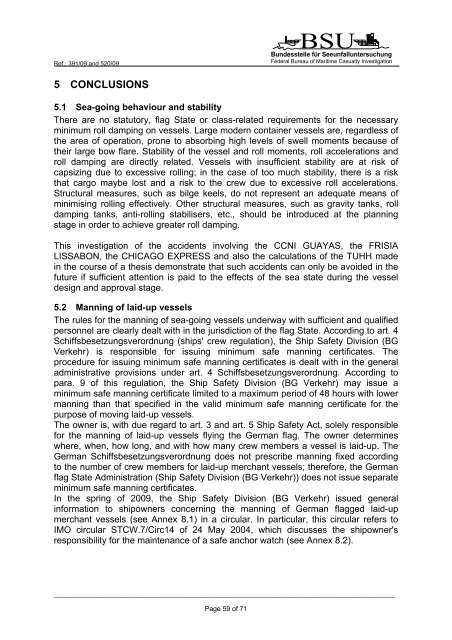SUB-COMMITTEE ON STABILITY AND LOAD LINES AND ON ...
SUB-COMMITTEE ON STABILITY AND LOAD LINES AND ON ...
SUB-COMMITTEE ON STABILITY AND LOAD LINES AND ON ...
You also want an ePaper? Increase the reach of your titles
YUMPU automatically turns print PDFs into web optimized ePapers that Google loves.
Ref.: 391/09 and 520/09<br />
BSU<br />
Bundesstelle für Seeunfalluntersuchung<br />
Federal Bureau of Maritime Casualty Investigation<br />
5 C<strong>ON</strong>CLUSI<strong>ON</strong>S<br />
5.1 Sea-going behaviour and stability<br />
There are no statutory, flag State or class-related requirements for the necessary<br />
minimum roll damping on vessels. Large modern container vessels are, regardless of<br />
the area of operation, prone to absorbing high levels of swell moments because of<br />
their large bow flare. Stability of the vessel and roll moments, roll accelerations and<br />
roll damping are directly related. Vessels with insufficient stability are at risk of<br />
capsizing due to excessive rolling; in the case of too much stability, there is a risk<br />
that cargo maybe lost and a risk to the crew due to excessive roll accelerations.<br />
Structural measures, such as bilge keels, do not represent an adequate means of<br />
minimising rolling effectively. Other structural measures, such as gravity tanks, roll<br />
damping tanks, anti-rolling stabilisers, etc., should be introduced at the planning<br />
stage in order to achieve greater roll damping.<br />
This investigation of the accidents involving the CCNI GUAYAS, the FRISIA<br />
LISSAB<strong>ON</strong>, the CHICAGO EXPRESS and also the calculations of the TUHH made<br />
in the course of a thesis demonstrate that such accidents can only be avoided in the<br />
future if sufficient attention is paid to the effects of the sea state during the vessel<br />
design and approval stage.<br />
5.2 Manning of laid-up vessels<br />
The rules for the manning of sea-going vessels underway with sufficient and qualified<br />
personnel are clearly dealt with in the jurisdiction of the flag State. According to art. 4<br />
Schiffsbesetzungsverordnung (ships' crew regulation), the Ship Safety Division (BG<br />
Verkehr) is responsible for issuing minimum safe manning certificates. The<br />
procedure for issuing minimum safe manning certificates is dealt with in the general<br />
administrative provisions under art. 4 Schiffsbesetzungsverordnung. According to<br />
para. 9 of this regulation, the Ship Safety Division (BG Verkehr) may issue a<br />
minimum safe manning certificate limited to a maximum period of 48 hours with lower<br />
manning than that specified in the valid minimum safe manning certificate for the<br />
purpose of moving laid-up vessels.<br />
The owner is, with due regard to art. 3 and art. 5 Ship Safety Act, solely responsible<br />
for the manning of laid-up vessels flying the German flag. The owner determines<br />
where, when, how long, and with how many crew members a vessel is laid-up. The<br />
German Schiffsbesetzungsverordnung does not prescribe manning fixed according<br />
to the number of crew members for laid-up merchant vessels; therefore, the German<br />
flag State Administration (Ship Safety Division (BG Verkehr)) does not issue separate<br />
minimum safe manning certificates.<br />
In the spring of 2009, the Ship Safety Division (BG Verkehr) issued general<br />
information to shipowners concerning the manning of German flagged laid-up<br />
merchant vessels (see Annex 8.1) in a circular. In particular, this circular refers to<br />
IMO circular STCW.7/Circ14 of 24 May 2004, which discusses the shipowner's<br />
responsibility for the maintenance of a safe anchor watch (see Annex 8.2).<br />
_____________________________________________________________________________________________________<br />
Page 59 of 71
















